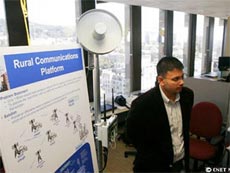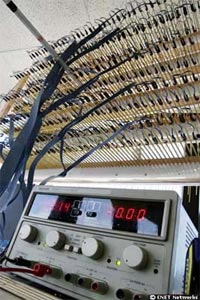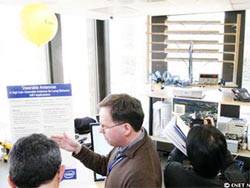Intel developed Wi-Fi technology far away ... 100km
A San Francisco-based computer can connect to Wi-Fi wireless networks in San Jose, California while the distance between two places is approximately hundreds of kilometers? What seems to be very difficult to do now has become a reality with the new Wi-Fi networking technology of the world's leading chip maker Intel.
Impossible variables are possible
With current Wi-Fi networks, the signal coverage area is usually only about 100 meters. But now, according to Eric Brewer, director of the Intel Research Berkeley lab, academics and scientists at Intel's lab have successfully established Wi-Fi systems capable of transmitting signals to the way they are. more than 100km (more than 60 miles).
 Intel developed Wi-Fi technology far away ... 100km Picture 1
Intel developed Wi-Fi technology far away ... 100km Picture 1
Intel's long-range Wi-Fi antenna system.Source CNET .
Mr. Eric said: ' This system includes hardware devices like other Wi-Fi networks but has software modifications '.
To demonstrate the system's performance, Intel has established a connection between its lab in the inner city area of the Bay Area and the University of California's space science laboratory, which is a reservation room. at 1,200 feet (365.76m) and 1.5 miles away at Grizzly Peak Avenue. The signal receiving device in this room consists of a directional antenna, connected to a WiFi Access Point transmitting device (like any normal wireless Access Point but has been edited).
It must be said immediately that this is not the system used to serve Europe and America. This initiative is part of efforts to bring computer technology to people in third world countries. Because in most of these countries, the communication infrastructure is still quite weak, almost all of the best is concentrated in the city, while the village is the place where the population is born. The most crowded means of communication with the outside world is nothing more than cars, buses and . trails.
 Intel developed Wi-Fi technology far away ... 100km Picture 2 The wire behind the antenna drives the Wi-Fi signal. Source CNET . According to Mr. Brewer, these new Wi-Fi antennas will act as an important link in the signaling chain through many Access Points. People can use this antenna right in their village area, because they will transmit signals through some other broadcast towers, until the last "dock" is a fiber optic cable to be able to connect. Internet to the village.
Intel developed Wi-Fi technology far away ... 100km Picture 2 The wire behind the antenna drives the Wi-Fi signal. Source CNET . According to Mr. Brewer, these new Wi-Fi antennas will act as an important link in the signaling chain through many Access Points. People can use this antenna right in their village area, because they will transmit signals through some other broadcast towers, until the last "dock" is a fiber optic cable to be able to connect. Internet to the village.
What is Intel's long-range Wi-Fi different from WiMax?
In fact, these long-range Wi-Fi antennas function as WiMax wide-area wireless coverage technology, a type of technology currently being developed by many companies, including Intel. An initial difference is that while WiMax broadcast towers are quite expensive (from $ 15,000 to $ 20,000), the price of Wi-Fi transmission towers ranges from $ 700 to $ 800.
Another point, Brewer said, is that long-range Wi-Fi networks will transmit signals faster. In addition, the radio that WiMax uses is coordinated by telecom operators, the construction of signal transceiver towers as well as WiMax service providers requires approval from the local authorities.
While Wi-Fi networks operate without permission, people can access the network at any time. By the end of this year, Intel will build testing of long-range Wi-Fi technology or some components of the technology in Uganda.
Method of antenna operation
One of the biggest differences between conventional Wi-Fi networks and Intel's wide-area Wi-Fi network is that long-range transmission signals are oriented: They will be tuned to be transferred directly from the antenna to the antenna. other than being "out of the way" out. Meanwhile, a normal Wi-Fi antenna will transmit signals to all directions in a circle of 3600.
 Intel developed Wi-Fi technology far away ... 100km Picture 3
Intel developed Wi-Fi technology far away ... 100km Picture 3
Alan Mainwaring, a scientist at Intel Research Berkeley, describes how signaling antennas work.Source CNET .
Setting up signals with such orientation is not easy. To do that, the antennas need to be installed to 'connect correctly' with each other. Any object interfering can affect the signal transmission process.
' It's hard to connect them. The first thing that happens most is that children can play on signal towers, 'admitted Alan Mainwaring, a scientist at Intel Research Berkeley.
To overcome this, Intel has come up with a type of antenna that can 'adjust' the direction of signal transceiver. Of course, at the antenna, it is impossible to drive the signal, but when the signal travels between two transmission towers, it can be adjusted by an electrical signal. Thanks to the electrical signal, the antennas do not necessarily align with each other, even when a little deviation, the integrity of the signal is still guaranteed.
Compared to the standard Wi-Fi communication process, Intel's long-range Wi-Fi network has omitted many protocols and connection procedures. Specifically, the process of "handshaking" - the process of letting the computer and the wireless router establish a connection in a regular Wi-Fi network - and the detection of the detector is also removed.
Do Duong
You should read it
- How to mount the antenna to capture most DVB-T2 channels
- The 2019 iPhone uses new type antennas, improving cellular signal reception in the home
- How to Make Your Own FM Antenna
- Signal Processing (Signal Handling) in C ++
- Function signal () in C
- How to delete Signal account
- Select the location of the router to increase the Wifi wave
- signal.h in C
- How to replace WiFi antenna on wireless router
- How to use stickers / stickers expressing emotions in Signal
- The app uses Wi-Fi to rescue people lost in the forest
- What color is the turn signal light? It's easy to think but 90% of people answer wrong






 New charging technology allows electric cars to charge for 3 minutes to travel 100km, as fast as filling gasoline
New charging technology allows electric cars to charge for 3 minutes to travel 100km, as fast as filling gasoline Intel introduces the practical experience of mobile devices
Intel introduces the practical experience of mobile devices Learn about Intel Platform Administration Technology - IPAT part 1
Learn about Intel Platform Administration Technology - IPAT part 1 Chinese hybrid cars run 2,100km on just one tank of gas
Chinese hybrid cars run 2,100km on just one tank of gas Intel is moving toward wireless computer technology
Intel is moving toward wireless computer technology Learn about Intel Platform Administration Technology - IPAT part 2
Learn about Intel Platform Administration Technology - IPAT part 2